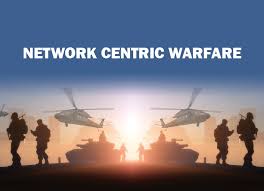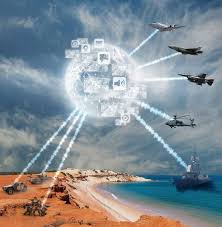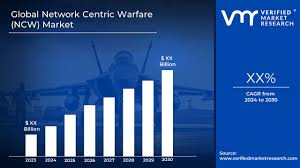
Introduction
Network-Centric Warfare (NCW) is a modern military strategy that leverages advanced communication networks, real-time data sharing, and artificial intelligence to enhance battlefield effectiveness. Unlike traditional warfare, which relies on isolated units making independent decisions, NCW connects soldiers, commanders, and autonomous systems into a unified digital network. This approach enables faster decision-making, improved situational awareness, and coordinated military responses, significantly increasing combat efficiency.
Core Principles of NCW
NCW is built on three fundamental principles:

- Information Superiority: The ability to collect, process, and distribute vast amounts of battlefield data in real-time, giving military forces a tactical advantage.
- Speed and Precision: NCW enhances the decision-making process by allowing instant communication between units, drones, satellites, and command centers.
- Interoperability: Different branches of the military, including land, air, sea, and cyber forces, are seamlessly integrated into a single operational framework.
Key Technologies in NCW
The success of Network-Centric Warfare depends on cutting-edge technologies that transform traditional combat into an interconnected digital battlefield.
- AI-Driven Battle Management: AI algorithms analyze real-time data from multiple sources, predicting enemy movements and suggesting strategic actions.
- Secure Communication Networks: High-speed encrypted networks ensure seamless and secure data exchange between military units worldwide.
- Unmanned Systems and Robotics: Autonomous drones, robotic soldiers, and AI-powered defense systems work in coordination with human troops for precision strikes and surveillance.
- Cyber Warfare and Electronic Countermeasures: NCW incorporates cybersecurity measures to protect military networks from hacking, while also using electronic warfare to disrupt enemy communications and radar systems.
- Augmented Reality (AR) and Heads-Up Displays (HUDs): AR-enhanced soldier helmets and AI-driven HUDs provide real-time battlefield information, reducing decision-making time for ground forces.

Advantages of NCW
Network-Centric Warfare offers several tactical and strategic benefits:
- Enhanced Situational Awareness: Every unit on the battlefield has access to real-time intelligence, ensuring a coordinated and informed military response.
- Rapid and Precise Operations: By integrating AI and automation, military actions can be executed with greater speed and accuracy, minimizing collateral damage.
- Reduced Casualties: Autonomous drones and robotic units can perform high-risk operations, reducing human exposure to danger.
- Global Military Coordination: NCW allows joint operations between allied nations, improving multinational defense strategies and rapid response capabilities.
Challenges and Risks
Despite its advantages, NCW comes with challenges and vulnerabilities:
- Cybersecurity Threats: A heavily networked system is a prime target for cyberattacks that could disable communication networks or manipulate battlefield data.
- Complex System Integration: Military forces must integrate legacy systems with new digital technologies, which can be costly and time-consuming.
- Data Overload: The vast amount of battlefield information requires advanced AI filtering to prevent commanders from being overwhelmed with excessive data.
Future of Network-Centric Warfare
As artificial intelligence, quantum computing, and advanced cyber warfare techniques continue to develop, NCW will evolve into an even more autonomous and AI-driven military strategy. Future NCW systems will integrate hypersonic weapons, space-based defense systems, and AI-driven swarm warfare tactics, redefining the way conflicts are fought.

Conclusion
Network-Centric Warfare is revolutionizing modern military strategies by leveraging advanced communication, AI, and cyber warfare to achieve superior battlefield awareness and combat effectiveness. While challenges such as cybersecurity and integration remain, the continued evolution of NCW will shape
